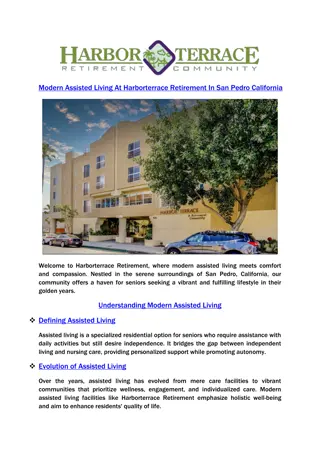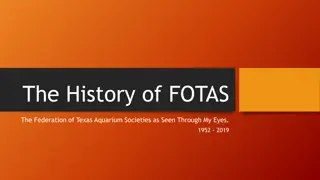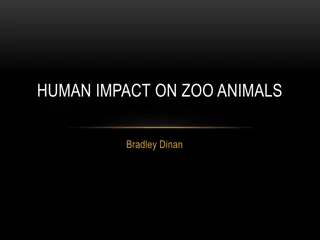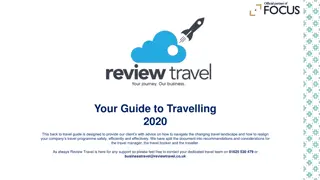Affordable Travel Boosts Zoo and Aquarium Visits
More affordable travel means more visits to local and national zoos and aquariums. Learn about the impact of travel costs on attendance, top US destinations, visitor statistics, and evolving views on animal rights versus species preservation. Explore strategies for promoting these attractions and encouraging tourism.
Download Presentation

Please find below an Image/Link to download the presentation.
The content on the website is provided AS IS for your information and personal use only. It may not be sold, licensed, or shared on other websites without obtaining consent from the author.If you encounter any issues during the download, it is possible that the publisher has removed the file from their server.
You are allowed to download the files provided on this website for personal or commercial use, subject to the condition that they are used lawfully. All files are the property of their respective owners.
The content on the website is provided AS IS for your information and personal use only. It may not be sold, licensed, or shared on other websites without obtaining consent from the author.
E N D
Presentation Transcript
More Affordable Travel=More Visits With zoos and aquariums both local and national attractions, families cost of travel significantly affects zoo and aquarium attendance and revenues. Although general economic conditions are favorable for 2017 travel, 42% of US adults responding to a May 2017 Skift survey said they were not taking a vacation this summer; however, another 35.2% said not yet, so more could make late plans. What could convince many of them to take a vacation, especially by car, is that as of June 9th, the national average for a gallon of gas was $2.35, the lowest on that date since 2005; and prices are expected to remain in this range throughout the summer.
Almost Everyone Enjoys a Zoo Visit According to the latest data from the Association of Zoos & Aquariums, there were 215 US accredited zoos and aquariums, with more than 183 million visitors, as of September 2016, a modest 1.1% increase since 2013 s 181 million visitors. During 2016, US zoos and aquariums provided informal science education to 50 million children visitors with families and 12 million students on field trips. The top 5 US zoos for 2017, according to USA Today Readers Choice Awards, were Saint Louis Zoo; Henry Doorly Zoo & Aquarium (Omaha); Arizona-Sonora Desert Museum (Tucson); Fort Worth Zoo; and Riverbanks Zoo & Garden (Columbia, SC).
Enter to the Aquatic World Voice of the Visitor, the 2016 Annual Outlook on the Attractions Industry, reported that 60% of survey respondents said they had visited the same aquarium previously. This compares to 84% for theme parks and 81% for zoos. Of 14 attractions listed in the report, aquariums were 7th, with 30% of people saying they visited aquariums during 2015. According to the Association of Zoos & Aquariums, Georgia Aquarium had the most visitors, 2.2 million, during 2016; followed by Monterey Bay Aquarium, 2.08 million; Shedd Aquarium, 2.02 million; and Aquarium of the Pacific, 1.6 million.
Animal Rights vs. Species Preservation Although the zoo, as we know it, has existed for almost 200 years, there is growing public clamor (and not just from vociferous animal-rights groups) and evidence that animals are not happy in zoos. The increasing interest in environmentalism has led SeaWorld to stop its killer whale (orca) breeding program and world-famous Ringling Bros. Barnum & Bailey Circus to close its doors (or tents) during early 2017. A number of major zoos have closed some exhibits, as the stress, lack of access to natural food sources and an inability to breed that various animal species are experiencing have become more evident as our understanding of animals increases.
Advertising Strategies Zoos and aquariums are some of the most promotion-heavy advertisers, so instead of trying to offer new ideas, it may be more beneficial to you and them to show how well your station s audience matches with their future promotions. Undoubtedly, many zoos and aquariums provide discounted admissions and membership fees for seniors, but they should also offer group rates for local senior tours and as an outing for older seniors at assisted-living facilities. To help defray the cost of travel and attract more moderate-income individuals and families, a zoo or aquarium may want to offer a gasoline card for use at a nearby station with a value that correlates to the total admission; for example, 10%, a $5 card for $50 in admissions.
New media Strategies As savvy marketers/promoters, zoos and aquariums are certainly maximizing their use of digital media. A possible idea is to select randomly a family and assign an employee to accompany the family for an hour, shooting video of their visit, for posting on social media. Zoos and aquariums can create behind-the-scenes videos showing the care of animals and personnel s interactions and special relationships with the residents. Personnel can explain their daily duties. Videos could even show live births, when appropriate for children. Zoos and aquariums may want to try LinkedIn to promote outdoor meeting facilities for local businesses/corporations as a respite from the board room or a daytime business retreat. Provide a group discount that includes admissions and a food ticket.























